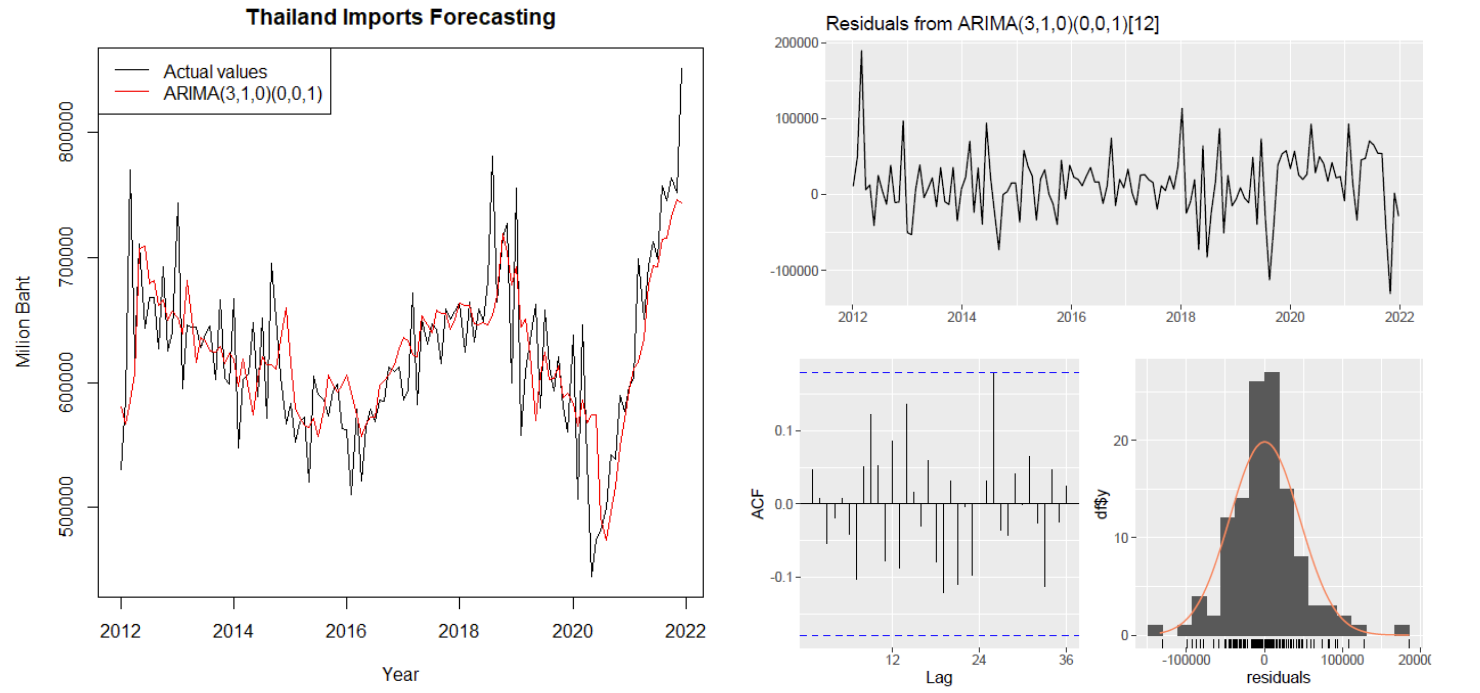Forecasting of Thai International Imports and Exports Using Holt-Winters’ and Autoregressive Integrated Moving Average Models
Keywords:
Imports, Exports, ARIMA model, Holt-Winters’model, Seasonal, ForecastingAbstract
Imports and exports are two vital issues of the Thai economy, which were ranked as the 23rd largest economy in the world in 2020. This research aimed to examine the monthly import and export volume trends (in million Baht) from January, 2010 to December, 2022. To conduct the analysis, the research employed Holt-Winters’ additive and multiplicative models, as well as various seasonal ARIMA models. The models were evaluated using different selection measure criteria, and the results indicated that the Holt-Winters’ multiplicative forecasting model was optimal for predicting both import and export volumes, as it produced the least mean absolute error (MAE) and root mean square error (RMSE). Therefore, it is recommended for future Thai imports and exports forecasts. However, it is notable that the COVID-19 pandemic had a significant impact on the country's imports and exports during the 2019-2020 period.
References
Benvenuto,D., Giovanetti,M., Vassallo,L., Angeletti, S.,& Ciccozzi,M.(2020).Application of the ARIMA model on the COVID-2019 epidemic dataset.Data in Brief, 29,105340.
Box, G. E. P.,& Jenkins,G. M.(1976).Time series analysis: forecasting and control.San Francisco, CA: Holden-Day.
Chatfield, C., & Yar, M.(2014). Holt-Winters forecasting: some practical issues.Journal of the Royal Statistical Society: Series D (The Statistician), 34(2-3), 215-225.
Fattah, J., Ezzine, L., Aman, Z., El Moussami, H., & Lachhab, A.(2018).Forecasting of demand using ARIMA model.International Journal of Engineering Business Management, 10,1–9.https://doi.org/10.1177/1847979018808673
Hyndman,R. J.,& Athanasopoulos G.(2021).Forecasting: Principles and Practice(3rded.).https://otexts.com/fpp3/decomposition.html
Kamoljitprapa, P.,& Sookkhee, S.(2022).Forecasting Models for Carbon Dioxide Emissions in Major Economic Sectors of Thailand.Journal of Physics: Conference Series 2346, 012001.
Kaur, P.,& Rakshit, M.(2019).Seasonal and Periodic Autoregressive Time Series Models Used for Forecasting Analysis of Rainfall Data.International Journal of Advanced Research in Engineering and Technology, 10(1),230-242.
Ministry of Energy. (2021).Thailand's energy situation. https://www.energy.go.th /en/energy-situation/energy-situation-in-thailand/
Mladenović,J., Lepojević,V.,& Janković-MilićV.(2016).Modelling and Prognosis of the Export of The Republic of Serbia by using Seasonal Holt-Winters and ARIMA Method.Economic Themes, 54(2),233-260.
Nieto,M. R., Carmona-Benitez,R. B.,&Martinez,J. N.(2021)Comparing models toforecast cargo volume at port terminals.Journal of Applied Research and Technology, 19(3),238-249.
OECD. (2017).Economic survey of Thailand 2017. https://www.oecd.org/ economy/surveys/economic-survey-thailand.htm
Office of the Permanent Secretary. (2023). Ministry of Commerce.https:// tradereport.moc.go.th/Report/ReportEng.aspx?Report=TradeEnBalanceYearly
Oghenekevwe, O. A., & Mercy, O. O.(2021). Forecasting Export and Import Performance in the Agricultural Sector of Nigeria Using ARIMA Models.International Journal of Agricultural and Biological Engineering, 14(4), 145-152.
Panday, P. K., & Dhakal, R.(2020). ForecastingExports and Imports of Nepal’s Agricultural Sector: A Comparison of ARIMA, ANN and ETS Models.International Journal of Applied Sciences and Biotechnology, 8(1), 15-20.
Trade Policy and Strategy office. (2022).Ministryof Commerce. https://www.tpso.moc.go.th /th/node/12413
Winters,P. R. (1960). Forecasting Sales byExponentially Weighted Moving Averages.ManagementScience, 6(3), 324-342.
Wongoutong,C.(2021).The Effect of Forecasting Accuracy of the Holt-WinterMethod When Using the Incorrect Model on a Non-Stationary Time Series.Thailand Statistician, 19(3),565-582.
World,Bank. (2022). World development indicators.https://databank.worldbank.org/source/world-development-indicators

Downloads
Published
License
Copyright (c) 2023 Journal of Applied Science and Emerging Technology

This work is licensed under a Creative Commons Attribution-NonCommercial-NoDerivatives 4.0 International License.

